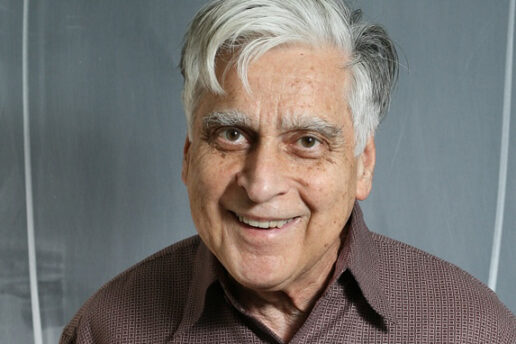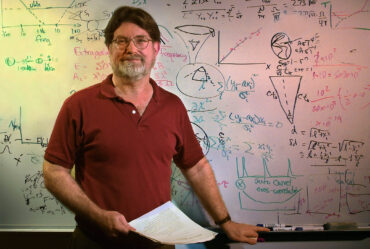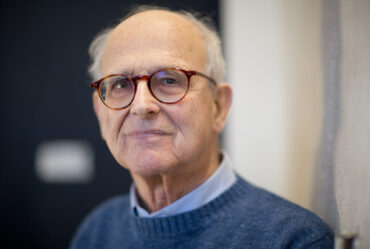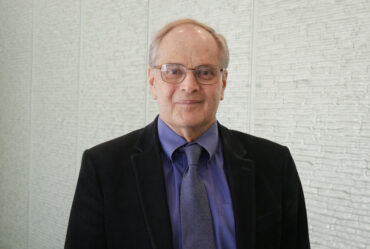
Professor Emeritus Earle Lomon, nuclear theorist, dies at 94
On the physics faculty for nearly 40 years and a member of the Center for Theoretical Physics, he focused on the interactions of hadrons and developed an R-matrix formulation of scattering theory.
Earle Leonard Lomon PhD ’54, MIT professor emeritus of physics, died on March 7 in Newton, Massachusetts, at the age of 94.
A longtime member of the Center for Theoretical Physics, Lomon was interested primarily in the forces between protons and neutrons at low energies, where the effects of quarks and gluons are hidden by their confinement.
His research focused on the interactions of hadrons — protons, neutrons, mesons, and nuclei — before it was understood that they were composed of quarks and gluons.
“Earle developed an R-matrix formulation of scattering theory that allowed him to separate known effects at long distance from then-unknown forces at short distances,” says longtime colleague Robert Jaffe, the Jane and Otto Morningstar Professor of Physics.
“When QCD [quantum chromodynamics] emerged as the correct field theory of hadrons, Earle moved quickly to incorporate the effects of quarks and gluons at short distance and high energies,” says Jaffe. “Earle’s work can be interpreted as a precursor to modern chiral effective field theory, where the pertinent degrees of freedom at low energy, which are hadrons, are matched smoothly onto the quark and gluon degrees of freedom that dominate at higher energy.”
“He was a truly cosmopolitan scientist, given his open mind and deep kindness,” says Bruno Coppi, MIT professor emeritus of physics.
Early years
Born Nov. 15, 1930, in Montreal, Quebec, Earle was the only son of Harry Lomon and Etta Rappaport. At Montreal High School, he met his future wife, Ruth Jones. Their shared love for classical music drew them both to the school’s Classical Music Club, where Lomon served as president and Ruth was an accomplished musician.
While studying at McGill University, he was a research physicist for the Canada Defense Research Board from 1950 to 1951. After graduating in 1951, he married Jones, and they moved to Cambridge, where he pursued his doctorate at MIT in theoretical physics, mentored by Professor Hermann Feshbach.
Lomon spent 1954 to 1955 at the Institute for Theoretical Physics (now the Niels Bohr Institute) in Copenhagen. “With the presence of Niels Bohr, Aage Bohr, Ben Mottelson, and Willem V.R. Malkus, there were many physicists from Europe and elsewhere, including MIT’s Dave Frisch, making the Institute for Physics an exciting place to be,” recalled Lomon.
In 1956-57, he was a research associate at the Laboratory for Nuclear Studies at Cornell University. He received his PhD from MIT in 1954, and did postdoctoral work at the Institute of Theoretical Physics in Denmark, the Weizmann Institute of Science in Israel, and Cornell. He was an associate professor at McGill from 1957 until 1960, when he joined the MIT faculty.
In 1965, Lomon was awarded a Guggenheim Memorial Foundation Fellowship and was a visiting scientist at CERN. In 1968, he joined the newly formed MIT Center for Theoretical Physics. He became a full professor in 1970 and retired in 1999.
Los Alamos and math theory
From 1968 to 2015, Lomon was an affiliate researcher at the Los Alamos National Laboratory. During this time, he collaborated with Fred Begay, a Navajo nuclear physicist and medicine man. New Mexico became the Lomon family’s second home, and Lomon enjoyed the area hiking trails and climbing Baldy Mountain.
Lomon also developed educational materials for mathematical theory. He developed textbooks, educational tools, research, and a creative problem-solving curriculum for the Unified Science and Mathematics for Elementary Schools. His children recall when Earle would review the educational tools with them at the dinner table. From 2001 to 2013, he was program director for mathematical theory for the U.S. National Science Foundation’s Theoretical Physics research hub.
Lomon was an American Physical Society Fellow and a member of the Canadian Association of Physicists.
Husband of the late Ruth Lomon, he is survived by his daughters Glynis Lomon and Deirdre Lomon; his son, Dylan Lomon; grandchildren Devin Lomon, Alexia Layne-Lomon, and Benjamin Garner; and six great-grandchildren. There will be a memorial service at a later date; instead of flowers, please consider donating to the Los Alamos National Laboratory Foundation.


